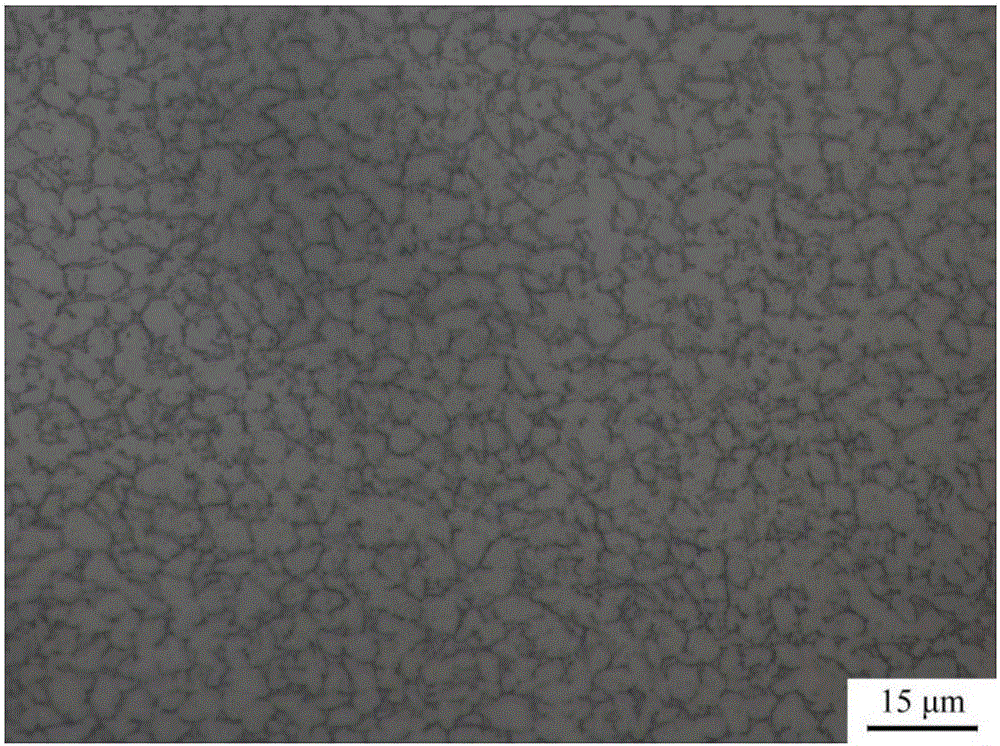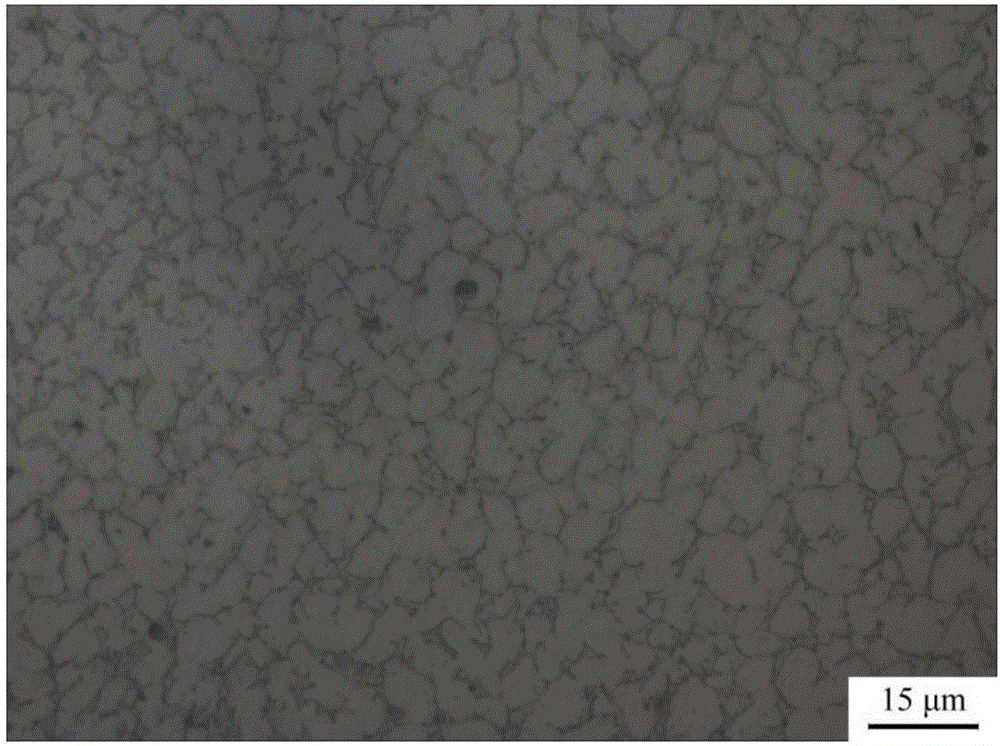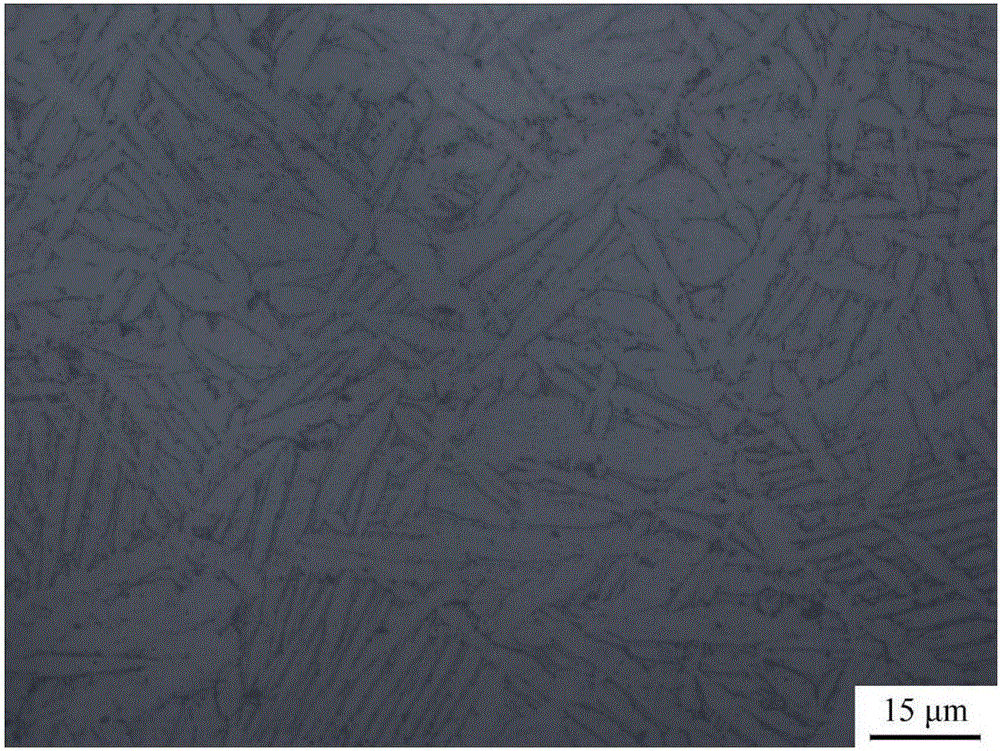Method for controlling grain equi-axiation to improve plasticity of Ti20Zr6.5Al4V alloy
A ti20zr6.5al4v, alloy technology, applied in the field of materials, can solve the problems of only 2.05% elongation, the urgent need to improve the plasticity, the effect is not obvious, etc., to achieve the effect of less difficulty in operation, low processing cost, and simple process flow
- Summary
- Abstract
- Description
- Claims
- Application Information
AI Technical Summary
Problems solved by technology
Method used
Image
Examples
Embodiment 1
[0025] Take the Ti20Zr6.5Al4V alloy bar, the mass percentage of its chemical composition is Ti: 67.1%, Zr: 18.8%, Al: 5.6%, V: 3.8%, and cut the alloy bar into Φ42×16mm round ingots with a wire cutting machine And clean up, the alloy ingot is put into the vacuum tube type electric resistance furnace heat (treatment furnace model: QSH-VTF-1200T; Manufacturer: Shanghai Quanshuo Electric Furnace Co., Ltd., the following examples are the same) to heat, using argon as the protective atmosphere, When the temperature rises to 970°C, keep it warm for 30 minutes, take out the alloy ingot and quickly put it in water for quenching; before rolling, use a box-type resistance furnace (model: KL-13; manufacturer: Tianjin Kaiheng Electric Heating Technology Co., Ltd., the following The embodiment is the same) the temperature is raised to 800°C at a heating rate of 10°C / min, and after holding the heat for 2min, the alloy ingot is rolled and deformed with a twin-roll mill at a rolling speed of 0...
Embodiment 2
[0027] Take the Ti20Zr6.5Al4V alloy bar, the mass percentage of its chemical composition is Ti: 67.1%, Zr: 18.8%, Al: 5.6%, V: 3.8%, and cut the alloy bar into Φ42×16mm round ingots with a wire cutting machine And clean it up, heat the alloy ingot in a vacuum tube resistance furnace, use argon as a protective atmosphere, when the temperature rises to 970 ° C, keep it warm for 30 minutes, take out the alloy ingot and quickly put it in water for quenching; before rolling, use The box-type resistance furnace raised the temperature to 850°C at a heating rate of 10°C / min. After holding the temperature for 4 minutes, the alloy ingot was rolled and deformed with a two-roll rolling mill. The rolling speed was 0.4m / s, and the single-pass pressing The amount is 1.5mm; after each pass of rolling, put the alloy into the heat treatment furnace for reheating, when the temperature rises to 850°C, keep it warm for 4 minutes and then roll again, repeat heating-rolling 7 times in this way until ...
Embodiment 3
[0029] Take the Ti20Zr6.5Al4V alloy bar, the mass percentage of its chemical composition is Ti: 66.5%, Zr: 18.7%, Al: 6.0%, V: 3.9%, and cut the alloy bar into Φ42×16mm round ingots with a wire cutting machine And clean it up, heat the alloy ingot in a vacuum tube resistance furnace, use argon as a protective atmosphere, when the temperature rises to 1050 ° C, keep it warm for 20 minutes, take out the alloy ingot and quickly put it in water for quenching; before rolling, use The box-type resistance furnace raises the temperature to 900°C at a heating rate of 10°C / min. After holding the temperature for 1min, the alloy ingot is rolled and deformed with a two-roll rolling mill at a rolling speed of 0.6m / s, and single-pass pressing The amount is 2mm; after each pass of rolling, put the alloy into the heat treatment furnace for reheating, when the temperature rises to 900°C, keep it warm for 1min and then roll again, repeat heating-rolling 5 times until the thickness of the alloy is...
PUM
| Property | Measurement | Unit |
|---|---|---|
| yield strength | aaaaa | aaaaa |
| size | aaaaa | aaaaa |
| size | aaaaa | aaaaa |
Abstract
Description
Claims
Application Information
 Login to View More
Login to View More - R&D
- Intellectual Property
- Life Sciences
- Materials
- Tech Scout
- Unparalleled Data Quality
- Higher Quality Content
- 60% Fewer Hallucinations
Browse by: Latest US Patents, China's latest patents, Technical Efficacy Thesaurus, Application Domain, Technology Topic, Popular Technical Reports.
© 2025 PatSnap. All rights reserved.Legal|Privacy policy|Modern Slavery Act Transparency Statement|Sitemap|About US| Contact US: help@patsnap.com



